Fermenting Beer with Wyeast 3068 Weihenstephan Weizen Yeast
Published: October 22, 2025 at 9:51:17 PM UTC
Wyeast 3068 Weihenstephan Wheat Yeast is a top choice for brewers aiming for the classic banana-clove taste of German hefeweizen. It's sold by trusted retailers that support new brewers with guides and guarantees. Many stores also offer free shipping on orders over certain amounts. Whether brewing a traditional Weihenstephan-style wheat beer or trying modern variations, knowing how to handle Weihenstephan Weizen yeast is crucial.
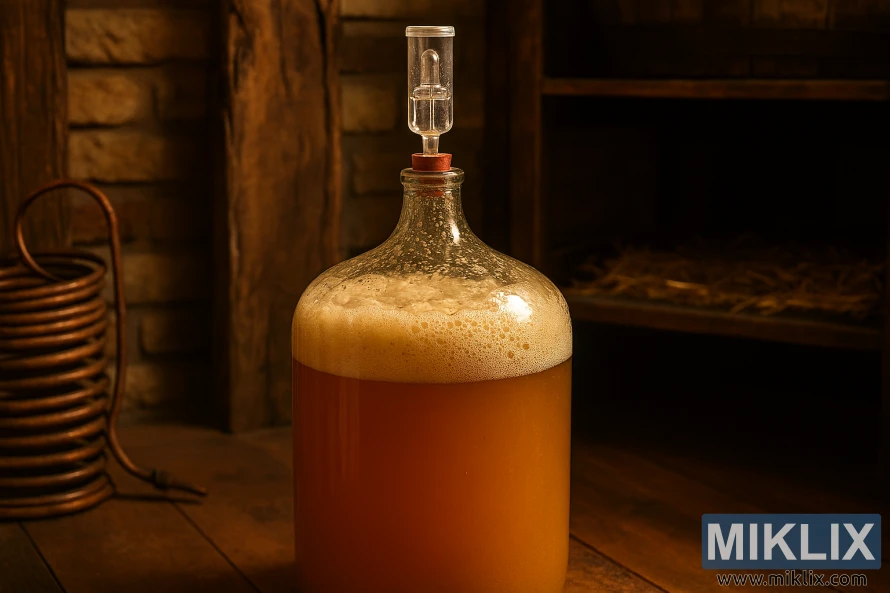
Key Takeaways
- Wyeast 3068 is tailored for hefeweizen yeast character: banana and clove esters.
- Available through major retailers that provide support and shipping incentives.
- Strong user reviews indicate reliable performance in homebrewing.
- Proper pitching, temperature control, and packaging shape final flavor.
- This article will cover packaging, pitching rates, and practical tips for U.S. brewers.
Overview of Wyeast 3068 Weihenstephan Wheat Yeast for Homebrewers
The Wyeast 3068 overview provides homebrewers with a detailed look at a classic Weihenstephan strain, adapted for today's brewing techniques. This yeast is celebrated for its ability to infuse traditional hefeweizen aromas and a soft mouthfeel into wheat beers.
The Weihenstephan wheat yeast profile showcases banana and clove esters, a hallmark many brewers aim for in authenticity. It is noted for reliable attenuation and moderate flocculation, resulting in a delightful haze in unfiltered pours.
Hefeweizen yeast characteristics include distinct phenolics and fruity esters that complement the sweetness of wheat malt. Wyeast and retailers offer guidance on pitch rates and temperature ranges to fine-tune the ester profile brewers desire.
- Strain identity: a Weihenstephan-derived wheat ale yeast tailored for classic hefeweizen flavors.
- Common use: frequent choice for hefeweizen, dunkelweizen, and other wheat variants among homebrewers.
- Retail attributes: sold in Wyeast smack packs with product Q&A and customer reviews for guidance.
Wyeast and brew shops offer advice on starter size, pitching temperatures, and handling to avoid off-flavors. Adhering to these recommendations ensures the preservation of the intended hefeweizen yeast characteristics, leading to consistent batches.
Understanding the Main Keyword: Fermenting Beer with Wyeast 3068 Weihenstephan Weizen Yeast
The main keyword definition revolves around the practical steps and flavor outcomes of using Wyeast 3068. This yeast strain is celebrated for its classic Weizen character. It produces banana esters and clove phenolics, which are hallmarks of Bavarian wheat beers.
For homebrewers looking to ferment with 3068, it's crucial to focus on temperature control and wort composition. Cooler temperatures tend to mute esters, while warmer temperatures enhance fruitiness. Adjusting the mash and grain bill is key to supporting phenolic expression without overwhelming the beer.
Here is a simple outline for fermenting with Wyeast 3068, ensuring a repeatable process for small batches.
- Prepare a healthy starter or use a fresh smack pack to ensure viability.
- Pitch at recommended rates to avoid over-pitching and to preserve ester balance.
- Set fermentation temperature in the low to mid 60s°F for balanced clove and banana.
- Monitor activity during the first 48–72 hours; vigorous krausen is normal for this strain.
- Allow a diacetyl rest if needed, then condition to clear esters and phenolics.
For those asking how to ferment with Wyeast 3068, small adjustments can make a big difference. A half-degree change in temperature can alter ester output. Using pilsner or pale wheat malts can enhance yeast character. Optional adjuncts like orange peel or coriander can add a crafty touch.
Understanding yeast behavior is key to predicting outcomes. Fermenting with 3068 requires careful control. When pitching, temperature, and oxygen management are done correctly, it yields an authentic Weizen profile.
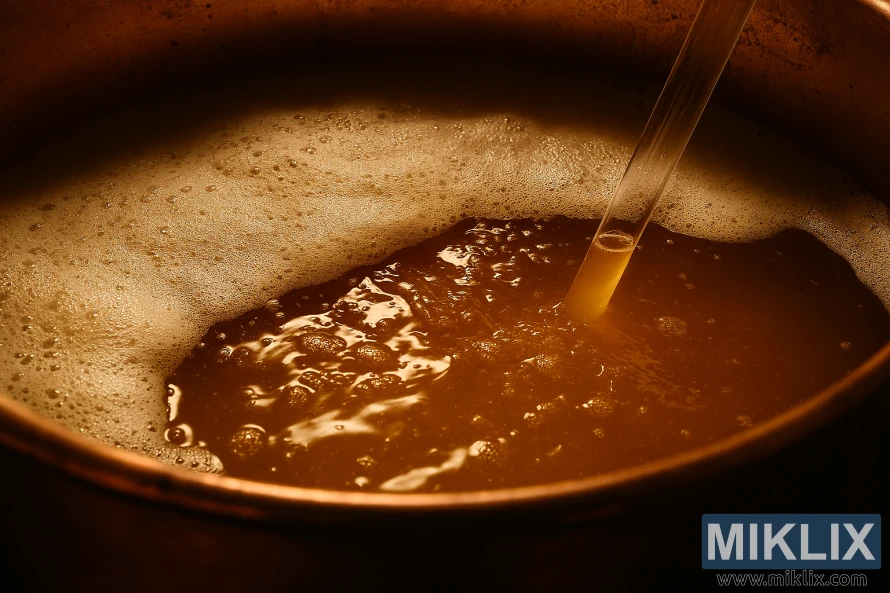
Packaging and What to Expect from a Wyeast Smack Pack
Wyeast 3068 is sold in an activated Wyeast smack pack. It combines liquid yeast with a small nutrient pouch called an Activator pack. This packaging keeps cells fresh and ready for pitching, ensuring viability when shipped and stored correctly.
Activating a pack leads to a short bloom period. A healthy Wyeast smack pack will foam and become visibly active within 12 to 48 hours. This foam indicates viable yeast, meeting the common expectations of homebrewers for a standard 5-gallon batch.
The volume and freshness of the yeast determine its viability. Wyeast guidance and brewer reports suggest a single activated pack is usually sufficient for ordinary-strength 5-gallon batches. For higher gravity beers or if the pack appears sluggish, brewing a starter can improve yeast health.
Retail support pages offer product details, Q&A, and reviews. It's important to check seller policies on satisfaction guarantees and shipping thresholds. These resources help confirm viability and set realistic expectations before brewing.
- Check the date and store conditions to judge freshness in yeast packaging.
- Watch for foam rise after activating the Activator pack as a sign of life.
- Scale up with a starter if you brew stronger beers or smaller batches where pitch volume matters.
Pitching Rates and Over-Pitching Concerns for Wyeast 3068
Opting for the right pitching rate for Wyeast 3068 is crucial for wheat beers that showcase banana and clove esters. A full 5-gallon Activator pack can be excessive for smaller batches. It may also dampen the distinctive ester profile these beers are known for.
Wyeast provides valuable guidance on scaling down yeast quantities. For a 3-gallon batch or a 1.048 OG wort, they recommend using about 75 ml (60%) or 62.5 ml (50%) of a fresh Activator pack. This method ensures the yeast's ester production is maintained, keeping the beer true to its style.
Practical calculations are effective when scaling down from a 5-gallon pack. Brewers can receive specific milliliter recommendations from Wyeast support to achieve the desired ester levels.
Over-pitching can lead to reduced ester formation, resulting in a cleaner, less fruity profile. This outcome might be suitable for some lagers but detracts from the expressiveness of Weizen styles fermented with 3068. To achieve consistent results, it's advisable to weigh or measure the portion used. Creating a small starter tuned to the batch size can also help.
- Estimate pitch fraction by volume: (Batch gallons ÷ 5) × pack volume.
- For a 3-gallon, 1.048 OG batch, target near 60% of a 5-gallon pack.
- When unsure, contact Wyeast support for ml-based guidance to hit desired ester profiles.
Keeping a record of pitches can help refine your technique over time. Document how different pitching rates of Wyeast 3068 affect the beer's aroma and flavor. Then, adjust the yeast quantity for future batches to achieve the desired outcome.
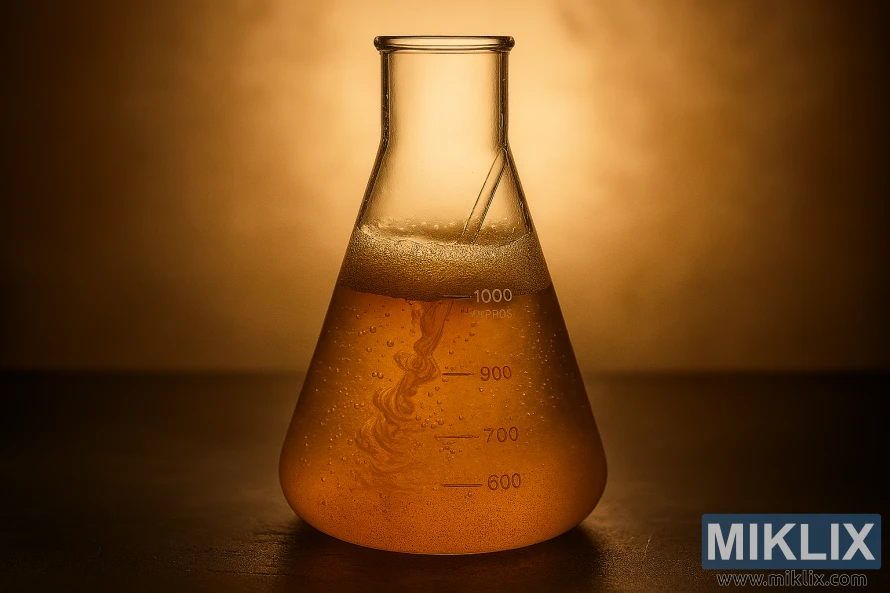
Fermentation Temperatures and Flavor Control with 3068
The Wyeast 3068 temperature range is crucial for a hefeweizen's flavor. Cooler temperatures enhance clove-like phenolics, while warmer ones boost esters and banana notes. This balance is key to achieving the desired taste.
For a banana-forward hefeweizen, aim for warmer temperatures. Wyeast recommends 72–73°F to emphasize isoamyl acetate, the banana compound. This temperature range ensures a clean, ripe fruitiness without unwanted off-flavors.
Prefer a clove-dominant or balanced flavor? Lower the fermentation temperature. Mid-range temperatures of 68–70°F strike a balance between banana and clove. Lowering further to the low 60s°F reduces esters, making clove more pronounced.
- Target ~72–73°F for strong banana ester expression when fermenting hefeweizen.
- Use 68–70°F for a balanced fermentation temperature banana clove balance.
- Consider low-60s°F if you want clove-dominant notes or minimal esters.
Practical temperature control is more important than exact numbers. Employ an external thermometer, swamp cooler, or temperature controller. Homebrewers successfully ferment hefeweizen across a wide range, but each degree affects the taste.
Monitor gravity and aroma during fermentation, not just temperature. Taste and smell are better guides than strict temperature rules. The right balance between Wyeast 3068 temperature range and your recipe will create the perfect banana-clove flavor.
Starter vs Direct Pitch: When to Make a Yeast Starter for 3068
Deciding between direct pitch vs starter hinges on yeast health, batch gravity, and pack age. For a fresh Wyeast smack pack, direct pitching often ensures clean fermentation in a typical five-gallon wheat beer.
Opt for a yeast starter Wyeast 3068 when facing higher original gravity, an older or partially viable pack, or needing faster fermentation. A starter boosts cell counts and shortens lag time. This reduces the risk of stressed yeast producing off-flavors.
Here's a quick checklist for deciding when to build a yeast starter:
- If original gravity is above 1.060, consider a starter to reach recommended pitch rates.
- If the pack is past its production date or has been improperly stored, build a starter to verify activity.
- If you want a rapid onset of fermentation for cleaner ester control, a starter helps.
Wyeast smack packs are designed for convenience. For standard 5-gallon batches, a fresh Wyeast 3068 smack pack usually has enough viable cells to skip a starter. For smaller batches, follow reduced-volume guidance rather than wasting part of the pack.
There are trade-offs to consider. Direct pitching saves time and reduces handling. Starters add steps, require equipment, and take a day or two. Starters improve viability and vigor for challenging batches and give peace of mind when pitch rates matter most.
Wyeast provides pitch-rate recommendations for 3068 and answers specific starter or pitch questions. When uncertainty remains, consult those guidelines or make a modest starter to protect the quality of your Weizen.
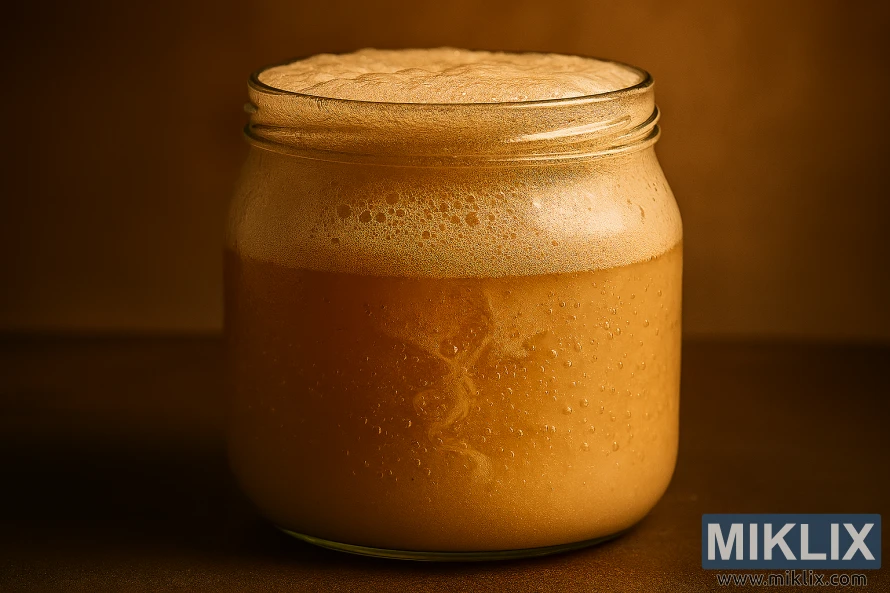
Fermentation Management: Preventing Blowoff, Sulfur, and Off-Flavors
Effective control begins with the fundamentals: ensuring Wyeast 3068 has ample space to ferment and a clear path for CO2 release. Employ a fermenter with ample headspace or install a blowoff tube to a carboy. These measures are crucial in preventing blowoff during the vigorous krausen stages.
The pitching rate significantly influences flavor outcomes. A proper pitch rate minimizes yeast stress and reduces the likelihood of sulfur off-flavors Wyeast 3068 may produce under-pitched conditions. If uncertain, consider building a starter or using multiple smack packs to achieve the necessary cell counts.
Temperature plays a pivotal role in fermentation control. Fermenting at low 60s°F slows activity and tames aggressive krausen, aiding in blowoff prevention and reducing fusel or solvent notes. Stable temperatures also mitigate off-flavor provocation.
Monitor fermentation vigor closely during the initial 48 to 72 hours. Vigorous, chaotic bubbling indicates intense activity; a blowoff tube or bucket headspace will safeguard equipment. On the other hand, gentle, steady bubbling signals a controlled ferment with fewer byproducts.
Implement these fermentation management strategies to aid yeast in clearing sulfur compounds during conditioning. Extended time on the yeast and a warmer diacetyl rest, if necessary, allow volatile sulfur to dissipate before packaging.
- Ensure ample headspace or blowoff tubing to prevent blowoff.
- Match pitching rate to batch gravity to minimize sulfur off-flavors Wyeast 3068.
- Hold steady temps in the low 60s°F for controlled fermentation when appropriate.
- Allow time for conditioning so residual sulfur can mellow.
Practical experience from brewers shows batches fermented in the low 60s°F often exhibit minimal blowoff and few sulfur issues. These real-world results validate the technical advice, making these fermentation management tips invaluable for homebrewers working with Wyeast 3068.
Recipe Building for Weizen Styles with Wyeast 3068
Begin by aiming for an original gravity between 1.045 and 1.055. This range ensures a balanced mouthfeel and keeps the beer refreshing. It also allows the yeast's unique characteristics to take center stage. For smaller batches, adjust the ingredients to maintain the desired gravity.
For a traditional hefeweizen, aim for a grain bill of 50–70% wheat malt. This will give the beer its signature soft, bready body. Use German Pilsner or Vienna as the base for the remaining 30–50%. Adding a small amount of Munich or Carahell can enhance color and add malt complexity.
Opt for low hop bitterness and choose neutral varieties like Hallertau or Tettnang. Aim for IBUs between 8–15 to ensure that the banana and clove esters from Wyeast 3068 dominate the flavor. Late hops or a minimal whirlpool addition will help preserve the subtle spice without disrupting the balance.
- Grain example: 60% wheat, 40% Pilsner for a classic body.
- Specialty: 2–4% Munich for depth, 1–2% acidulated malt to adjust pH if needed.
- Adjuncts: avoid strong flaked oats or rye that mask yeast character.
Follow recipe tips for 3068 on pitch rate and temperature control to balance banana vs clove. Warm ferment temperatures (66–72°F) favor banana esters. Cooler ranges (62–66°F) increase clove phenolics. Adjust pitch size and a brief diacetyl rest to clean fermentation up.
When formulating mash plans, choose a single infusion mash around 148–152°F. This balances body and fermentability. Raise mash temp slightly for fuller mouthfeel or drop it for a drier finish. Keep mash steps simple to showcase wheat and yeast interactions.
- Target OG: 1.045–1.055.
- Wheat ratio: 50–70% in the hefeweizen grain bill.
- Hops: neutral varieties, 8–15 IBUs.
- Ferment: manage temps per recipe tips for 3068 to shape esters and phenols.
Try small variations across batches to understand how your setup affects Wyeast 3068. Track mash temp, original gravity, pitch rate, and fermentation profile. These notes will help refine your Weizen recipe Wyeast 3068, ensuring the next brew meets your taste preferences.
Fermentation Timeline and Signs of Healthy Fermentation
Expect Wyeast 3068 to kickstart fermentation quickly. A healthy pack usually begins within 12–48 hours after pitching. Primary fermentation for a hefeweizen can last several days, influenced by temperature and pitch rate.
Signs of fermentation activity are clear. Krausen forming on the wort surface is the first indicator. Steady bubbling in an airlock or blowoff tube confirms this. A consistent drop in specific gravity over 24–48 hours shows yeast are actively working.
Healthy fermentation indicators go beyond bubbles. A thick, persistent krausen and even yeast sediment buildup indicate successful fermentation. Aroma changes to bready, clove, or banana notes typical of 3068 show the strain's character.
If you see no movement after 48 hours, check a few things. Verify pack freshness, confirm fermentation temperature, and review your pitch volume. Making a starter or repitching from an active culture can revive a stuck batch.
Wyeast guidance and brewer reports emphasize consistent temperature control and correct pitch rates for reliable results. Monitor gravity readings and visual cues to adjust before fermentation stalls.
- 12–48 hours: first visible activity
- Several days: primary fermentation common for hefeweizen
- No activity after 48 hours: check viability and conditions
Comparing Wyeast 3068 to Other Weizen Yeasts and Brands
Wyeast 3068 is known for its balanced banana and clove flavors. This is achieved when the pitch rate and temperature are carefully managed. Brewers often choose it to create a classic Bavarian Weizen character. They aim for clean esters and measured phenolics.
When comparing yeasts, it's important to note how different strains affect the flavor balance. Some Weihenstephan variants emphasize phenolic clove notes. On the other hand, Bavarian isolates tend to highlight ester-driven banana and bubblegum flavors. This makes yeast selection crucial for achieving the desired taste.
Brand support is also a significant factor for homebrewers. Wyeast offers detailed guidance on starters, pitching rates, and temperature ranges. This level of technical support can be a deciding factor when comparing suppliers and hefeweizen yeast brands.
Community feedback consistently shows 3068's reliable performance across batches. This is when fermentation variables are controlled. Homebrewers often report predictable attenuation, reliable flocculation, and consistent flavor outcomes with modest temperature changes.
Opt for Wyeast 3068 if you aim for a classic Weizen profile and value vendor guidance. This helps in achieving a balanced flavor. For those looking to experiment or prefer stronger phenolic notes, consider other weizen strains. Compare them to find the perfect match for your recipe.
- Profile: balanced banana/clove with manageable phenolics.
- Support: strong technical guidance from the manufacturer.
- Consistency: reliable across multiple small and medium batches.
Practical Tips for Small-Batch Brewers Using Wyeast 3068
Homebrewers in small kettles must scale Wyeast 3068 carefully. A full smack pack can over-pitch a 3-gallon brew, which is risky at an OG near 1.048.
To scale the smack pack, portion the activator. Wyeast recommends about 75 ml (around 60%) for smaller batches. For a gentler pitch, use 62.5 ml (50%). Spoon the activator into sanitized glass and pitch that amount to avoid rapid, underdeveloped fermentation.
- 3-gallon batch tips: if the pack date is old or gravity is high, build a starter to boost viable cell count.
- Keep fermenter headspace and a simple blowoff tube handy during peak krausen to prevent mess and lost beer.
- Track temperatures daily. Warmer fermentation (72–73°F) favors banana esters, mid-range (~69°F) balances esters and clove, and cooler temps bring out phenolic clove notes.
If unsure about pack freshness, start with a small starter. It ensures a predictable cell count and reduces yeast stress in high-gravity wort.
To control aroma, adjust temperatures stepwise during active fermentation. Brewers find clean runs with minimal blowoff when fermenting in the low 60s°F for restrained activity.
Adopt these small-batch pitching Wyeast 3068 practices and scaling smack pack methods. They make 3-gallon batch tips practical and repeatable in your homebrew routine.
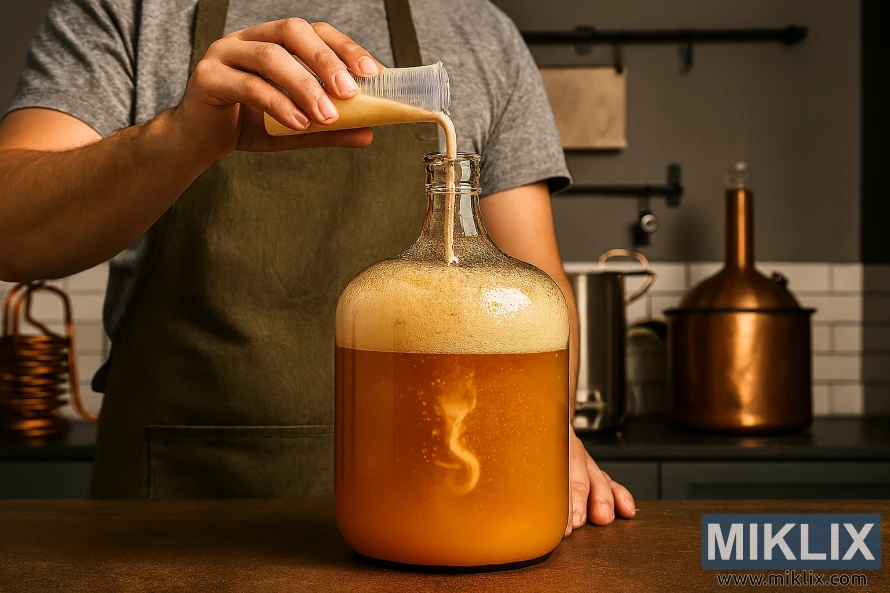
Packaging, Carbonation, and Serving Best Practices for Weizen
Wait until primary fermentation is over and the beer is clear before packaging. If you notice sulfur or off-flavors, wait longer. This allows time for these compounds to fade before transferring.
Choose the right packaging for your needs. Kegging offers control for draft service. Bottling supports natural conditioning and traditional presentation. Check with suppliers like White Labs or Wyeast for details on yeast viability, return policies, and shipping.
For authentic weizen character, aim for lively carbonation. High carbonation enhances yeast-driven aromas and the creamy mouthfeel. Adjust your priming sugar or keg CO2 to achieve the perfect carbonation level.
Measure carbonation levels in weizen by volume of CO2. Aim for the upper end of typical wheat beer ranges. Use a chart or digital gauge for consistent volumes. Bottle conditioning takes weeks at cellar temperatures; kegging offers faster, repeatable results.
Serve weizen cold but not ice cold. Temperatures around 45–50°F bring out banana and clove esters without overpowering them. Use tall Weizen glasses to showcase the voluminous head and aroma.
Pour technique is crucial for serving hefeweizen. Start with a steady pour to leave some yeast in the bottle for a cloudy presentation. Finish upright to build a dense, billowing head that carries the beer’s signature clove and banana notes to the nose.
Store packaged bottles or kegs away from heat and sunlight. Rotate stock to ensure older packages are consumed first. Clear labeling of brew date and carbonation method helps maintain quality during storage.
- Package timing: confirm complete fermentation and conditioning.
- Carbonation levels weizen: aim for lively volumes to lift aroma.
- Serving hefeweizen: use Weizen glasses and proper pour technique.
Conclusion
Wyeast 3068 stands out for those aiming to brew a classic hefeweizen. It reliably produces banana esters and clove phenolics, key to the style. Brewers should follow Wyeast's advice on reduced pack volumes for small batches to avoid over-pitching and preserve aroma.
Fermenting with 3068 requires careful planning. Use fresh smack packs for typical 5-gallon beers or build a starter for higher gravity or viability. Maintain steady fermentation temperatures to control flavor—cooler for clove, warmer for banana. Proper blowoff and sanitation are crucial to prevent off-flavors like sulfur.
This weizen yeast review concludes with a key takeaway. Careful pitching, attention to temperature, and regular fermentation monitoring are essential. Following these steps ensures consistent, authentic Weizen results with Wyeast 3068. Home and small-batch brewers have confirmed this through their experiences and Wyeast support.
Further Reading
If you enjoyed this post, you may also like these suggestions:
- Fermenting Beer with Fermentis SafAle K-97 Yeast
- Fermenting Beer with Fermentis SafAle US-05 Yeast
- Fermenting Beer with Mangrove Jack's M10 Workhorse Yeast
